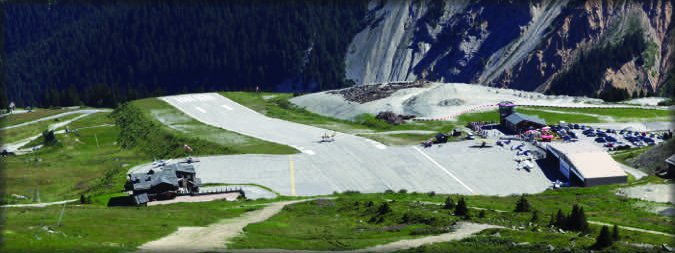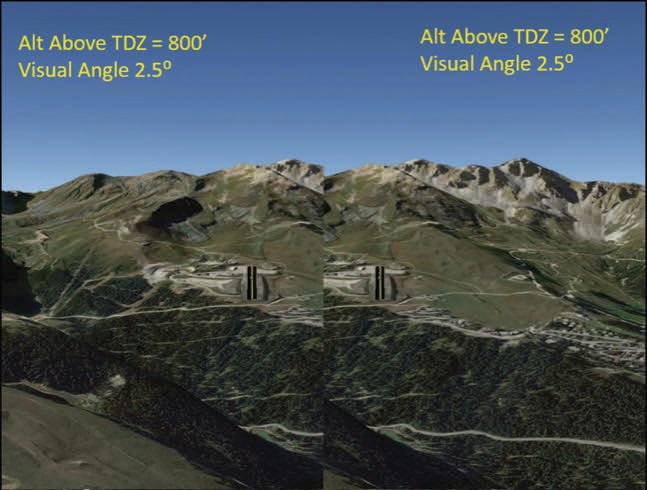
Optical illusions are all around us. A classic example might be when looking through a camera and a slow-turning airplane propeller or the wheel spokes on a car appear to slow and then reverse direction. None of that happens, of course; part what we “see” is determined by how well our eyes and brain work and play together. The bad news is there are many other optical illusions, and they can actually be quite dangerous if encountered while flying. The good news is we can understand them, anticipate them, then compensate for them.
I used to think that I only needed to concern myself with the prescription of my glasses when it came to how well I perceived things, but optical illusions don’t discriminate against those of us with less than 20/20 vision. Perfect eyes can be fooled by the illusions brought on by linear perspective, upslope, downslope, runway width, false references, repeating patterns and autokinesis. Over the course of my life I have experienced most of these, but one of them, the black-hole illusion, or black-hole approach as pilots sometimes call it, remained a mystery.
One factor that prolonged my understanding of the black-hole illusion was that I didn’t do a lot of night flying, the scenario where the illusion most often happens. I worked as a bush pilot in a land far away for most of my flying career and there wasn’t much need to fly at night. On the rare occasion when I did, it typically near or over a city with lots of lights. Recently I had a reason for rethinking this optical illusion and discovered it can sneak up on you even when the sun is out.
Cracking The Code
As a refresher, let’s review what the FAA says about this phenomenon. The black-hole approach illusion typically occurs when a landing is made over water or non-lighted terrain where the runway lights are the only source of light. When all the peripheral visual cues are absent, the straight-line glideslope can become a curved or drooping one, sometimes resulting in a landing short of the runway. The black-hole approach leads the aviator into thinking all is well—until trees appear in the windscreen.

As mentioned earlier, night flying wasn’t an issue with me so I didn’t fret over a black-hole approach, but then something happened that got my attention. I work as a safety officer for a group of flight departments scattered around the world. Some of our aircraft have the ability to record flight parameters such as position, altitude, airspeed and power settings. I enjoy analyzing data so I take the opportunity to review approaches anytime they become available. While engaging in this nerdy pastime, I noticed that there were quite a few approaches where things would start out fine and then approximately halfway down the approach, power would increase and the descent rate would flatten out. My curious mind began to wonder why our professional pilots were dragging in their approaches. It would have been easy to attribute this to laziness or lack of skill in flying a precise approach, but I knew these pilots and they exhibit neither of those traits in their flying.
That curved approach looked very similar to the approaches I saw in the recorded data with one exception—none of the flights involved flying at night. They did have one thing in common with each other though: They all were approaches to runways having an upslope. Upslope runways on landing are a favorite for our pilots because it means less runway is needed to stop.
I contacted the authors of some well-written articles on the black-hole approach phenomenon and asked if such an illusion could happen because of runway slope. The answer I got back was…yes, sloped runways actually increase the likelihood of a black-hole approach. My interest was piqued and I found myself reading a good deal of material on optics, trigonometry and how the human brain interacts with the outside world through sight.
Enter The Eyeball
Eyesight is truly amazing. Light reflected off the world around us is projected onto the back of our eyes through a bio-mechanical lens system that automatically adjusts for distance and light levels. The back of the eye is covered with photoreceptors that take this focused light and converts it to electrical impulses that the brain then interprets as the world around us. You might remember from your schooling that a lens sits in front of the eyeball and that it receives the light reflected from an object and focuses it on the back of the eye in a fashion similar to the illustration in Figure 2.

Usually we are quite adept at estimating the size and distance of an object familiar to us. If a car appears small (subtends a small visual angle on the back of our eyes), then we estimate that car to be a certain distance away. But if we take a model of a car and move it closer to our eyes while removing any supporting evidence (such as the big hand holding the car), we can be fooled into seeing a full-size car. Filmmakers do this all the time with miniatures. But what does this have to do with landing an airplane?
Figure 2 gives a clue to why the black hole is so tricky. When landing at night, most of the visual cues available during daylight hours are missing. Trees, buildings, other aircraft and such are absent, and all we are left with is the shape of the runway outlined with lights. As we fly a normal, constant-angle approach to the touchdown point, the runway will appear to grow in length because the visual angle it subtends onto the back of our eye increases. Without supporting evidence to the contrary, our brains interpret this as being high on the approach. Pilots typically don’t like to be high on the approach because of the possibility of overshooting the runway, so we increase our descent rate to keep the runway the same length (same visual angle). The picture in the window that served us so well during daylight hours now tricks us into flying a drooping approach that, if left unchecked, could lead to intercepting the ground well before the runway surface.
Even In Daytime?
After all of this study, I finally understood why a black-hole approach can be so deceptive, but how can a pilot be fooled by this during the daylight hours? It all goes back to the visual angle and how the brain interprets the information sent to it. I mentioned that I was seeing shallow approaches performed on sloping runways in my review of flight data. That’s because any approach to a sloped runway or a runway that is higher than the surrounding terrain—such as on a mesa—can lead to the same trickery.
Google Earth is a great tool. Geographic points can be plotted and show distances and altitudes in their proper relationship. Instead of just wondering how an approach might proceed if we allowed it to be influenced by a visual angle, we can now test it.

I decided to use the runway at Courcheval, France, as my test subject. I started by drawing a rectangle that matched the corners of the runway. This helped define the shape of the runway and gave more precision when taking measurements. I then drew an approach that started 800 feet above and 9200 feet away from the approach end of the runway. This formed a glidepath of five degrees to the runway. Using the measuring tools in Google Earth, I could then take the trigonometry Ms. Martindale taught me in high school and compute all the angles between the aircraft position and the runway. After plugging the numbers into Excel (see the table), I found that when positioned at the very beginning of the approach, the runway shape will subtend a visual angle of 2.5 degrees on the back of the eye. Your brain will now take this information and make a determination on how we are positioned in relation to the runway.
While following the straight line between the start of the approach and the end of the runway, I descended 100 feet and recomputed the visual angle. I found it increased to 2.7 degrees. I continued this method until I was only 100 feet above the end of the runway and found the visual angle had increased to 9.3 degrees. I also measured the perceived length of the runway and discovered it appeared to have grown 275 percent in length compared to how I perceived its length at the beginning of the approach. Since we know that runways don’t grow in size, your brain can perceive this change as being high on approach even though you are exactly on glideslope.

I started the approach again, but this time maintained the visual angle to the runway by drooping/curving the approach. The runway appeared to remain the same length and the only growth was with the runway width. The runway seemed to remain the same length, but my stabilized approach was shot to pieces.
This experiment used a sloped runway so as to allow the approach to continue below the altitude of the runway in order to make a point. During the day, the supporting information provided by the trees rushing up at you and hikers below ducking and waving you off the approach would probably prevent you from flying into the dirt. By this time, however, the approach would no longer be stabilized and would have to be performed again if the rising terrain allowed for a go-around. At night, without visual cues to assist, such an approach, even over flat ground to a level runway, would most likely result in landing well short of the threshold.
Here’s the bottom line: When making an approach, you’ll need to understand what factors are coming into play. Sometimes our perception of the world around us can lead to error. Optical illusions can be entertaining in the movie theater but in the real world, they can really bite you.
Glenn Grubb has flown Helio Couriers and Pilatus Porters in Indonesia with JAARS and has some 6000 hours. He’s earned COM/INST/A&P tickets and is deputy director of international aviation safety for JAARS Inc., in Waxhaw, N.C.




